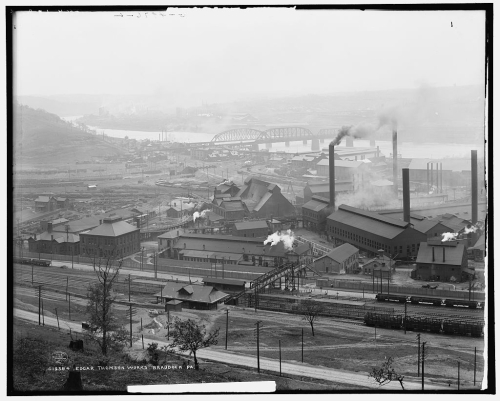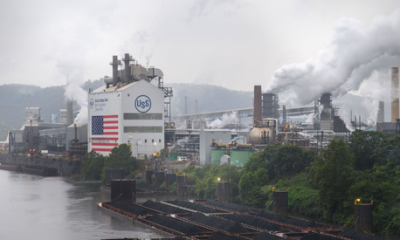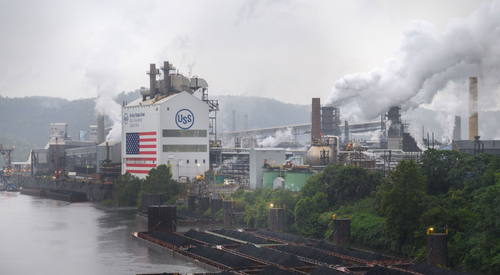Base Metals
US Steel partners with NETL to test new NETL membrane for carbon capture from steelmaking operations
The National Energy Technology Laboratory (NETL) and United States Steel Corporation plan to test an advanced membrane technology to capture CO2 emissions…

The National Energy Technology Laboratory (NETL) and United States Steel Corporation plan to test an advanced membrane technology to capture CO2 emissions generated by steelmaking operations at the company’s Edgar Thomson Plant, located in Braddock, Pennsylvania. The Edgar Thomson Plant, part of the Mon Valley Works, is the last integrated steel producer in Pennsylvania with blast furnaces and basic oxygen furnaces.
The project is part of the US Department of Energy (DOE)/NETL Point Source Carbon Capture Program. Point source carbon capture from industrial facilities, such as iron and steel manufacturing plants, is a vital element to reduce CO2 emissions. Carbon capture has the potential to reduce CO2 from blast furnaces.
That makes point source carbon capture at iron and steel plants a priority. The testing of this promising NETL-developed membrane at the Edgar Thomson Plant is an important step to move this groundbreaking technology closer to commercial deployment.
—NETL’s David Hopkinson, technical portfolio lead for Point Source Carbon Capture
Compared to other separation technologies, such as solvents and sorbents, polymer membranes offer a comparatively simple CO2 separation process. Membranes require few moving parts and no CO2 regeneration step, resulting in potential cost savings. Additionally, the simplicity of membrane-based processes offers the advantage of reduced capital and maintenance costs.
Membrane-based carbon capture uses permeable materials that allow for the selective separation of CO2 from flue gas.
Using our technology, we hope to generate a high-purity CO2 with a low percentage of nitrogen from flue gas so it can be safely and permanently stored in deep geologic formations or used as a feedstock to manufacture valuable fuels and chemicals and for other productive purposes.
—David Hopkinson
Lab-scale tests of the membrane were completed recently at DOE’s National Carbon Capture Center (NCCC) in Wilsonville, Alabama, which is used to evaluate cost-competitive carbon capture technologies for power plants. Based on the positive results from the NCCC testing, the expanded field test will be undertaken at the Edgar Thomson Plant and seek to separate CO2 from greater volumes of flue gas.
Currently, the design of the test unit to conduct gas separation measurements on the membrane is underway at NETL. In addition, a polymer membrane casting machine has been installed at NETL to allow for the production of larger membrane sheets as the technology is scaled up from lab scale to pilot scale.
This project sets the stage for the development of membrane technology that can be used at steel mills, cement kilns and other industrial sites that generate significant volumes of greenhouse gas.
—David Hopkinson
The unit is scheduled to be installed at the Edgar Thomson Plant in early 2025. The field test will run for approximately six months. Project funding was allocated by the DOE/NETL Point Source Carbon Capture Program to develop the next generation of advanced CO2 capture concepts to support the United States in achieving ambitious goals for a GHG-neutral economy by 2050, a carbon-pollution-free power sector by 2035 and a 50% reduction from 2005 levels in economy-wide net GHG pollution by 2030.
The Mon Valley Works consists of:
-
Clairton Plant – produces coke and coke byproducts;
-
Edgar Thomson (ET) Plant – produces hot iron in blast
furnaces, which is then converted into steel at the Basic Oxygen
Shop and then molded into slabs at the Caster; -
Irvin Plant – finishes and processes steel slabs;
-
Fairless Plant – includes a finishing mill, located outside
of Philadelphia.
Edgar Thomson Plant
The Edgar Thomson Works was Andrew Carnegie’s first steel mill and was the first large Bessemer steel plant in the area; it has been operating since 1875.
Edgar Thomson Works, c 1908. Library of Congress.

White House Prepares For “Serious Scrutiny” Of Nippon-US Steel Deal
White House Prepares For "Serious Scrutiny" Of Nippon-US Steel Deal
National Economic Adviser Lael Brainard published a statement Thursday…
How to Apply for FAFSA
Students and families will see a redesigned FAFSA this year. Here’s how to fill it out.
Dolly Varden consolidates Big Bulk copper-gold porphyry by acquiring southern-portion claims – Richard Mills
2023.12.22
Dolly Varden Silver’s (TSXV:DV, OTCQX:DOLLF) stock price shot up 16 cents for a gain of 20% Thursday, after announcing a consolidation of…












